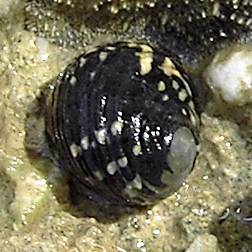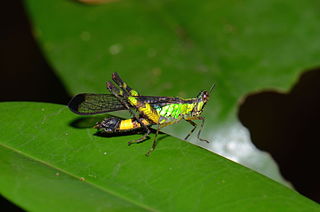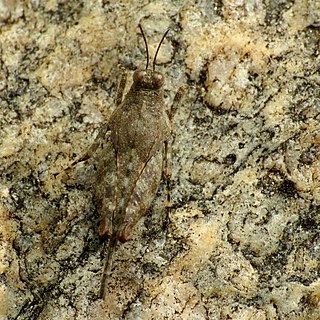
Pentatomidae is a family of insects belonging to the order Hemiptera, generally called shield bugs or stink bugs. Pentatomidae is the largest family in the superfamily Pentatomoidea, and contains around 900 genera and over 4700 species. As hemipterans, the pentatomids have piercing sucking mouthparts, and most are phytophagous, including several species which are severe pests on agricultural crops. However, some species, particularly in the subfamily Asopinae, are predatory and may be considered beneficial.

Bandwings, or band-winged grasshoppers, are the subfamily Oedipodinae of grasshoppers classified under the family Acrididae. They have a worldwide distribution and were originally elevated to full family status as the Oedipodidae. Many species primarily inhabit xeric weedy fields, and some are considered to be important locusts:

Tetrigidae is an ancient family in the order Orthoptera, which also includes similar families such as crickets, grasshoppers, and their allies. Species within the Tetrigidae are variously called groundhoppers, pygmy grasshoppers, pygmy devils or "grouse locusts".

Gryllotalpa is a genus of insects in the mole cricket family Gryllotalpidae.

Nerita is a genus of medium-sized to small sea snails with a gill and an operculum, marine gastropod molluscs in the subfamily Neritinae of the family Neritidae, the nerites.

The Phaneropterinae, the sickle-bearing bush crickets or leaf katydids, are a subfamily of insects within the family Tettigoniidae. Nearly 2,060 species in 85 genera throughout the world are known. They are also known as false katydids or round-headed katydids.

Tetrix ceperoi, Cepero's groundhopper, is a member of the family Tetrigidae and is very similar to common grasshoppers. Grasshopper is defined as a "plant eating insect with long hind legs that are used for jumping and for producing a chirping sound". However, unlike the common grasshopper, the wings of T. ceperoi extend beyond its pronotum. The front wings have evolved throughout history to be stumps, and the back wings are very well developed. Thanks to the front wings only, T. ceperoi is capable of flying. Furthermore, T. ceperoi sports wide shoulders while covering its narrow abdomen beneath the pronotum. T. ceperoi are classified as Orthoptera, which describes crickets, grasshoppers, and locusts. Furthermore, these Orthoptera have incomplete metamorphosis, which also affects sexual dimorphism later. T. ceperoi reach an average length of about 10 millimetres (0.39 in). T. ceperoi is a multi-coloured ground dweller with the ability to blend into its surroundings. The ability of T. ceperoi to be different colours makes it able to evolve colour schemes better adapted to specific habitats. This cryptic nature of their outer layer provides protection from predators as it is able to blend into its surroundings. T. ceperoi is diurnal, which means it is solely active in the daytime. However, although it is diurnal, it continues to hibernate during a late nymphal instar or later on in life as adults.

Eurydema is a genus of mostly Palaearctic shield bugs in the family Pentatomidae.

Erianthus is a genus of grasshoppers restricted to Southeast Asia. They occur in Japan, northeast India, Myanmar, Thailand, Vietnam, South China including Hong Kong, and extend east to Sumatra. In the past some neotropical species were also included in the genus. They have narrow ranges and species are identifiable only by their characteristics of male and female genitalia.

Tetrix subulata is the type species of groundhopper in the genus Tetrix, known as the slender ground-hopper, awl-shaped pygmy grasshopper and the slender grouse locust. It is found across the Palearctic: in North America, across much of Europe and Asia, from the British Isles east to Siberia, and to the southern parts of North Africa.

Tetrix undulata, the common ground-hopper, is a species of groundhopper in the Orthoptera: Caelifera.

Calliptamus is a genus of grasshoppers in the family Acrididae. Species of Calliptamus are found in Africa and the northern Palearctic realm through to Japan.

Paratettix is a genus of ground-hoppers or pygmy grasshoppers, with more than 60 described species found worldwide.

Tetriginae is a large subfamily of groundhoppers or pygmy grasshoppers. Members of Tetriginae occur on every continent except Antarctica.
Tetrix brunnerii, known generally as the Brunner's pygmy grasshopper or Brunner's grouse locust, is a species of pygmy grasshopper in the family Tetrigidae. It is found in North America.
Tetrix ornata, known generally as the ornate pygmy grasshopper or ornate grouse locust, is a species of pygmy grasshopper in the family Tetrigidae. It is native to North America.
Ergatettix is an Asian genus of ground-hoppers in the subfamily Tetriginae.
















